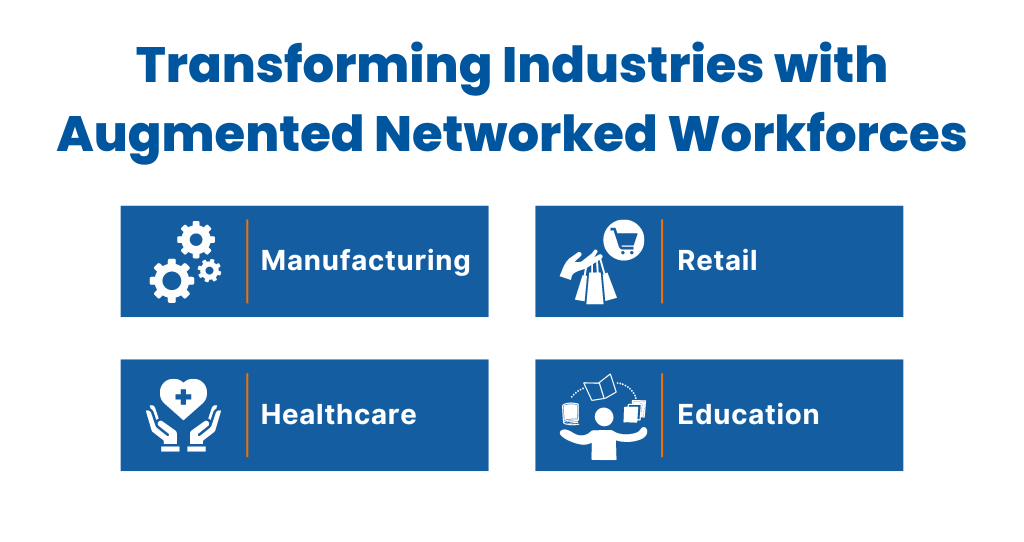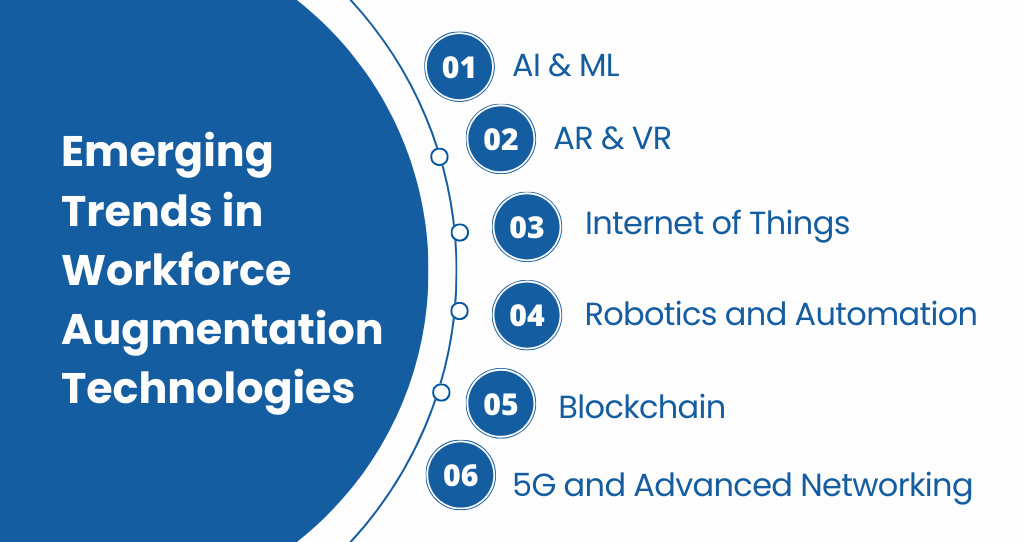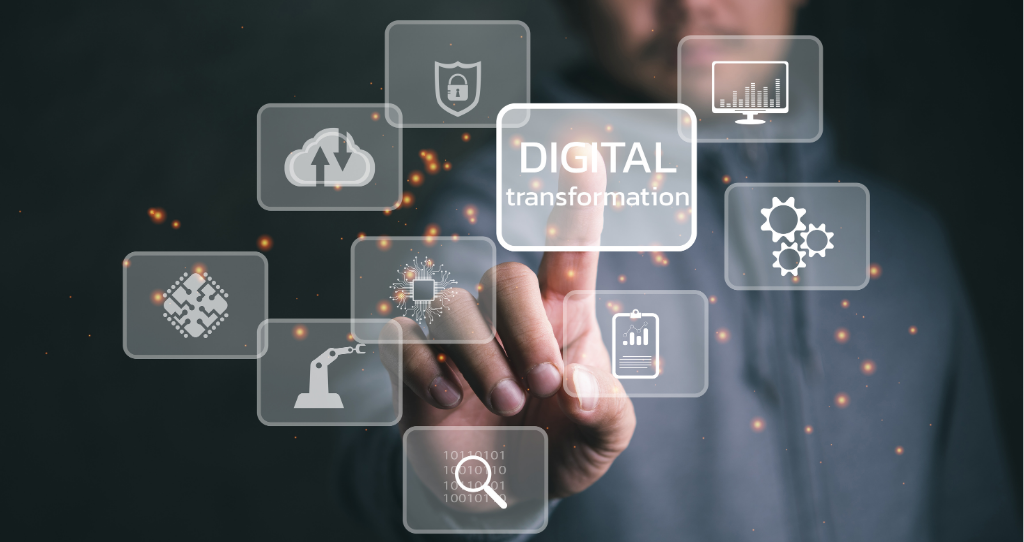
-
Apexlink
Real Estate
-
DLS
General Insurance
-
DMV
Government
-
Entiger
Fintech
-
GIS Mapping
Gas & Petroleum
-
HMS
Employee Benefit
-
HAWA
Government
-
Harley
Community
-
IHG
Hotel & Tourism
-
Sparkseeker
Humane Tech
-
Track Ninja
Sports
-
Response Vision
Disaster Management
- AI/ML Services
- Application Services
- Automation Services
- Cyber Security
- Chatbot Experts
- Data Analysis
- Data Warehouse Services
- Digital Commerce Services
- Digital Transformation
- Infrastructure Service
- Low Code/No Code
- Managed IT Services
- IT Support
- IT Consulting
- IT Outsourcing
- Mobile App Development
- IOS Development
- Android Development
- Cross Platform Development
- Gaming App Development
- Software Development
- System Design & Architecture
- Testing Services
- Web Development
Imagine a world where your skills are not just your own but augmented by a constellation of digital geniuses! Augmented connected workforces are bringing this vision to reality.
But what’s that?
An augmented connected workforce is a unique form of smart cooperation between human employees and an array of digital innovation and advanced technologies, including artificial intelligence, machine learning, augmented reality, virtual reality, and IoT. This synergy allows for a profound transformation in how employees carry out their activities by improving skill, access to information and capabilities, as well as how they collaborate remotely.
Why settle for traditional when the boundaries of the augmented workforce beckon us to explore beyond?
The ‘Why’ Behind Pushing Boundaries in Workforce Augmentation
Innovation and continuous improvement are unavoidable in cutting-edge businesses today, and leading-edge workforce augmentation is all about adopting new technology and developing a learning culture.
According to a recent Gartner report, 50% of office workers in global enterprises will be AI-augmented in one form or another by 2026. This forward momentum is crucial for a number of reasons such as:
- Enhanced Productivity: By leveraging human resources and technology, businesses can increase their efficiency and output manifold—other benefits include reducing time and resources spent on routine tasks.
- Competitive Advantage: Companies that lead in adopting and integrating new technologies set themselves apart in the market. Such companies are better prepared to handle change, innovate, and deliver exceptional customer value.
- Employee Satisfaction and Retention: A workforce empowered with tools and technologies that make their jobs more accessible and engaging will likely be more satisfied and committed to their employer.
- Future-Proofing: As industries evolve, so do the skills required. A commitment to pushing the boundaries ensures that organizations and their workforce remain relevant and adaptable.
How Augmented Networked Workforces are Transforming Industries

The current landscape is ripe for the transformation brought on by an augmented networked workforce. Across various sectors, we're witnessing the beginning stages of what promises to be a comprehensive overhaul of how work is done:
Manufacturing
Integrating IoT devices, AI, and AR on the factory floor has led to the rise of smart manufacturing facilities. These technologies allow for real-time monitoring, predictive maintenance, and a more agile response to production needs.
Healthcare
Telemedicine, augmented reality for surgery assistance, and AI for diagnostic processes exemplify how an augmented workforce can lead to more accessible and higher-quality healthcare services.
Retail
AI and AR are revolutionizing the retail experience, from personalized shopping recommendations to virtual fitting rooms, enhancing customer service and operational efficiency.
Education
Virtual and augmented reality technologies are breaking down geographical barriers, offering immersive learning experiences that were previously unimaginable.
Workforce Augmentation Technologies Currently in Focus

The landscape of workforce augmentation technologies is vast and varied, encompassing tools and platforms that enhance human capabilities, improve communication, and ensure seamless integration between workers and digital systems. Here's an overview of the key technologies reshaping the modern workforce:
AI & ML
AI/ML is at the forefront of workforce augmentation, providing capabilities that range from predictive analytics and decision-making to natural language processing and chatbots. AI-augmented software development can automate complex tasks, offer insights from large datasets, and augment human decision-making processes with predictive models. In customer service, AI-powered chatbots provide 24/7 support, while in finance, AI and ML are used for fraud detection and personalized investment strategies.
AR & VR
AR/VR technologies revolutionize training and operational procedures by creating immersive experiences. For instance, AR can overlay digital information onto the physical world, aiding in complex assembly tasks in manufacturing or surgical procedures in healthcare. Conversely, VR offers a fully immersive environment ideal for risk-free training scenarios, such as emergency response drills or complex surgical training, enhancing learning outcomes and procedural efficiency.
Internet of Things
The IoT connects physical devices to the internet, allowing for data exchange and analysis that can drive efficiency and innovation. In the workplace, IoT applications range from smart office environments that optimize energy use and space to wearable devices that monitor health and safety conditions for workers in hazardous environments. IoT sensors can monitor soil moisture and crop health in agriculture, informing precision farming practices.
Robotics and Automation
Robotics and automation technologies extend human capabilities, especially in performing repetitive or dangerous tasks. Collaborative robots (cobots) work alongside humans in factories, taking on physically demanding tasks while humans focus on more strategic activities. Automated guided vehicles (AGVs) and drones streamline inventory management and delivery processes in warehousing and logistics.
Blockchain
While primarily known for its financial applications, blockchain technology also offers significant benefits for workforce augmentation through its ability to secure and streamline data sharing and transactions. In supply chain management, blockchain enhances transparency and traceability, enabling more efficient and secure processes. It also holds promise for credential verification in HR processes, ensuring the authenticity of employee records and achievements.
5G and Advanced Networking
The rollout of 5G networks is set to dramatically enhance the capabilities of augmented workforce technologies by offering faster, more reliable connectivity. This improvement is crucial for the real-time data transfer required in remote operations, AR/VR applications, and IoT devices, ensuring that workforce augmentation technologies can be used to their full potential without lag or disruption.
As these technologies continue to evolve, they promise to bring even more profound changes to how we work, learn, and interact.
Benefits and Limitations of Existing Technologies
Implementing workforce augmentation technologies has unlocked numerous benefits for organizations and their employees. However, these advancements come with their own set of limitations and challenges that need to be navigated.
Benefits:
- Automating repetitive and time-consuming tasks allows employees to focus on more strategic, creative, and impactful work.
- Technologies like AR and IoT wearables can significantly reduce workplace accidents by providing real-time data and insights on potential hazards.
- AI and ML offer predictive analytics and data-driven insights, aiding in more accurate and timely decision-making.
- Digital technologies enable organizations to scale operations quickly to meet demand without the linear increase in human resources.
- Advanced networking and communication technologies facilitate seamless remote work and global collaboration, breaking geographical barriers.
Limitations:
- The initial investment in technology and ongoing maintenance, updates, and training costs can be significant.
- There is a growing skill gap as the demand for digital literacy and specialized knowledge increases, requiring significant investment in training and education.
- With the increasing reliance on digital technologies, organizations face heightened risks related to data breaches, privacy, and cybersecurity.
- Overreliance on technology can lead to vulnerabilities, especially if systems fail or are compromised.
- The deployment of AI and automation raises ethical questions about job displacement, surveillance, and the dehumanization of the workplace.
Augmented Connected Workforce Trends to Watch Out For
As we look to the future, several emerging trends are poised to revolutionize the augmented connected workforce further, promising to address some of the existing limitations while unlocking new capabilities.
AI and ML Advancements
Continued advancements in AI and ML are expected to make these technologies even more powerful and accessible. This includes the development of more sophisticated natural language processing and computer vision capabilities, which will enable more natural interactions between humans and machines.
Edge Computing
Edge computing processes data closer to where it is generated (at the "edge" of the network), reducing latency and bandwidth use. This trend is particularly important for real-time IoT and AR/VR applications, enabling faster and more reliable responses.
Digital Twins
A digital twin is a virtual representation of a physical object or system. This technology is gaining traction for its ability to simulate real-world conditions, allowing for testing, monitoring, and optimizing processes in a virtual environment before applying changes in the real world.
Collaborative Robots and Advanced Automation
The next generation of robots and automated systems will be more adaptable, safer, and capable of more complex tasks. These systems will work more closely with human workers, complementing their skills and offering new opportunities for collaboration.
Blockchain for Security and Transparency
Blockchain is expected to be more prominent in securing digital transactions and ensuring data integrity. Its application in credential verification, supply chain management, and secure data sharing will continue to grow.
Sustainable Technology Integration
Sustainability is becoming a critical consideration. Technologies that offer environmental benefits, such as energy-efficient data centers, sustainable AI algorithms, and green IoT devices, are expected to become more prevalent.
Enhanced Connectivity
The continued rollout of 5G and the development of 6G networks will provide the backbone for more immersive and interactive technologies, such as AR/VR and IoT, enabling more dynamic and connected workforce solutions.
The landscape of the augmented connected workforce is evolving rapidly, driven by existing technologies and new trends. As we navigate this transition, it will be crucial to balance innovation with ethical considerations, ensuring that the future of work is both productive and inclusive.
Privacy and Security Concerns that Cannot Be Ignored

As organizations increasingly adopt technologies to augment their workforce, privacy and security are critical concerns. The interconnected nature of these technologies means they enhance productivity and open up new vulnerabilities and ethical dilemmas.
Data Privacy
Collecting and analyzing vast amounts of personal and operational data raises significant privacy issues. Technologies like IoT devices, wearables, and AI-driven analytics can inadvertently expose sensitive information, making it imperative for organizations to enforce stringent data protection measures and comply with privacy regulations like GDPR and CCPA.
Cybersecurity Risks
The augmented connected workforce relies heavily on digital technologies, making cybersecurity a paramount concern. The proliferation of connected devices and systems increases the attack surface for cyber threats, including data breaches, ransomware attacks, and phishing schemes. Ensuring robust cybersecurity measures, including encryption, multi-factor authentication, and regular security audits, is crucial.
Ethical Implications
Using surveillance technologies and data analytics to monitor employee performance and behavior can lead to ethical dilemmas. Organizations must navigate the fine line between enhancing productivity and infringing on employees' privacy and autonomy, fostering a culture of trust and transparency.
How to Ensure Seamless Integration with Existing Systems?

Successfully implementing workforce augmentation technologies often hinges on seamless integration with existing systems and processes. This integration poses several challenges but is essential for maximizing the benefits of new technologies.
Compatibility Issues
Legacy systems may need to be more readily compatible with new technologies, requiring upgrades or custom solutions to bridge the gap. Ensuring compatibility is essential for the smooth exchange of data and the practical application of augmented technologies.
Change Management
The introduction of new technologies necessitates organizational changes, including employee training programs and adjustments in workflow processes. Effective change management strategies are critical to minimize disruption and ensure that employees can effectively leverage new tools.
Scalability and Flexibility
As organizations grow and technologies evolve, systems must be scalable and flexible to accommodate new capabilities and capacities. Planning for future growth and technological advancements ensures that investments in augmentation technologies remain relevant and beneficial.
Learning from Examples: Siemens and Its Digital Factory

Siemens, a global electronics and electrical engineering powerhouse, operates one of the world's most advanced digital factories in Amberg, Germany. This facility manufactures programmable logic controllers (PLCs), which are crucial components for automated machinery in various industries.
Siemens' Amberg plant exemplifies the concept of an augmented connected workforce through its extensive use of digital technologies, including automated production lines, industrial IoT, digital twins, and more. And the result? Well, this digital factory in Amberg boasts a defect rate of less than 0.001%. It has significantly increased its productivity over the years while maintaining a flexible and responsive production line capable of customizing products to individual customer requirements.
The Amberg plant is a testament to the potential of the augmented connected workforce in manufacturing.
The Bottom Line
As we stand on the brink of this transformative era, the augmented connected workforce offers a glimpse into a future where technology enhances, not replaces, human capabilities. This future demands careful consideration and strategic planning, but it holds the promise of reshaping industries and redefining the very nature of work.
Do you want to make the most out of an augmented connected workforce?
Let's connect to discuss!
Frequently Asked Questions
What is augmented workforce?
An augmented workforce refers to a scenario where human workers collaborate with digital workers, cobots, or intelligent virtual assistants to enhance safety, efficiency, and productivity in the workplace.
What is an augmented worker?
An augmented worker is an employee whose performance is enhanced through collaboration with technological tools, allowing them to carry out more specialized tasks with a higher degree of quality.
What is AI workforce augmentation?
AI workforce augmentation refers to the integration of AI technologies to empower human workers, making them more productive, efficient, and effective in their roles. It involves a collaborative approach where AI systems and human employees work together to achieve better results than either could achieve in isolation.







 Blockchain
Blockchain Cloud Computing
Cloud Computing Infrastructure
Services
Infrastructure
Services Metaverse
Metaverse QA
Automation
QA
Automation UI/UX
UI/UX







